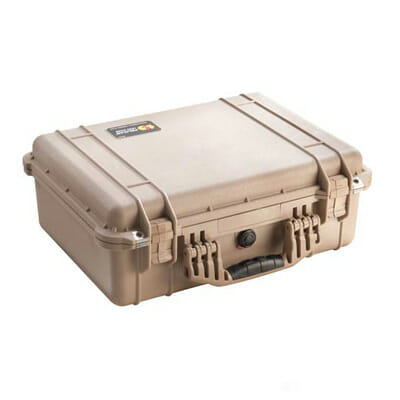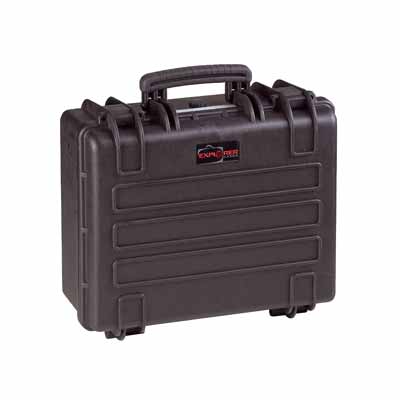Packaging for maritime and marine applications
Properties required for successfully shipping products
If your business ships specialist or industrial products internationally via sea freight, or has engineers working in offshore locations, maritime packaging is essential to your success.
But what exactly is maritime packaging?
Maritime packaging for industrial shipments includes large waterproof cases, wooden shipping crates, and glass-reinforced plastic (GRP) containers. Smaller cases, such as Peli™ and Explorer cases, are well-suited for protecting tools and equipment in offshore maintenance applications.
Maritime packaging must protect contents from moisture, humidity, temperature fluctuations, and any physical damage.
When it comes to maritime packaging — cases and containers —certain characteristics are essential regardless of your specific application. Understanding the types of maritime packaging, the scenarios in which they are most critical, and the key qualities they must possess can make all the difference in ensuring your cargo arrives safely.
In this guide, we’ll explore these aspects in detail and offer insights on choosing the most suitable packaging solution for your unique needs.
Contents
Introduction
Maritime packaging applications
In an increasingly connected world, there are numerous ways to ship goods. Air freight, road haulage, and rail transport are all vital in many supply chains.
However, more than 90% of all goods transported globally are carried by sea freight at some point. This makes shipping by sea – and, by extension, maritime packaging – crucial to many industries.
Yet the marine environment is particularly hostile, presenting a wide range of ways goods can be damaged during sea transport.
Damage caused during transit can prove costly, with customer rejections, project delays and even loss of reputation for your company significantly impacting your business’s ongoing success.
Offshore and marine maintenance
In addition to international shipping of goods, the maintenance of vessels, offshore rigs or other marine environments also requires maritime packaging.
For example, engineers working on oil drilling platforms use specialist tools and equipment that can cost thousands of pounds. These tools need protection from the elements and other forms of damage.
Damage or loss of tools is obviously costly. However, the potential loss of productivity and the health and safety implications of being unable to perform essential maintenance and repairs are even more serious.

Seven crucial characteristics of maritime packaging
Key points to consider when sourcing maritime packaging
Given how vital it is to get products to your customers undamaged and the need for offshore engineers to do their jobs, the importance of your packaging cannot be overstated.
As such, there are seven crucial characteristics of maritime packaging:
- Resistance to moisture and humidity.
- Prevents corrosion (of metal products).
- Unaffected by changes in temperature.
- Protects against impact and vibration.
- Provides adequate structural stability.
- Includes clear labelling and signage.
- Adheres to relevant regulations.
Protection against moisture and humidity
Saltwater, moisture, and humidity
Shipping by sea exposes your goods to wet conditions and saltwater, which can lead to damage. Therefore, ensuring that your packaging offers robust resistance to moisture ingress is imperative.
Carefully selecting materials and employing suitable protective packaging is vital. However, it’s essential to acknowledge that resistance to salt water and humidity extends beyond the choice of packaging material and encompasses design and construction as well.
Additionally, consider the duration of exposure to moisture and salt water during marine transport. Depending on the voyage’s duration and environmental conditions, supplementary protective measures, such as moisture absorbers or desiccants, may be necessary to maintain a dry interior environment within the packaging.
These considerations also extend to the protective cases used to store tools, equipment, and kits for offshore engineers.
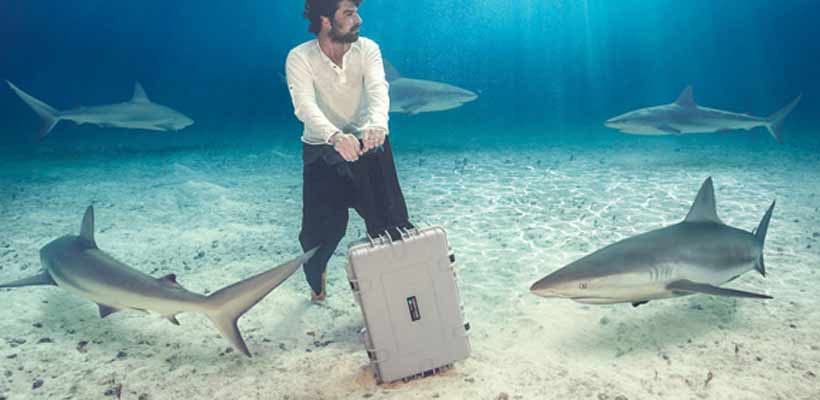
Prevents corrosion
Is VCI packaging also required?
If you are shipping large industrial parts or components, they may also be susceptible to corrosion-related damage.
Marine environments are, understandably, particularly prone to conditions that could cause damage to your shipments in this way.
As such, your maritime packaging may need to include measures to protect against this. VCI packaging (volatile corrosion inhibitor), in the form of wraps, papers, or specialist coatings, can be essential.
Protection against impacts and vibrations
Physical protection for goods during transit
Alongside the challenges of salt water, you’ll need to consider protecting your goods against impact and vibration that are likely during transportation and general handling.
Ensuring your maritime packaging and cases can effectively absorb impacts and shield contents from potential damage is paramount.
Incorporating cushioning materials, such as foams and corner protectors, is advisable to achieve this. These materials serve as an extra layer of defence, mitigating risks during transit and minimising the likelihood of damage to your cargo.
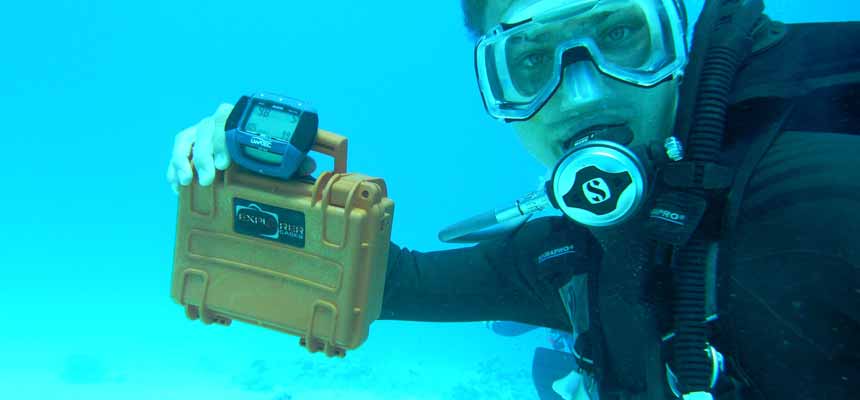
Provides adequate structural stability
Ensuring safety for loads
The packaging utilised for maritime transport must possess sufficient strength to endure the demanding conditions it will encounter.
Your goods may undergo stacking, loading, unloading, and handling at ports, warehouses, and on vessels (and other modes of transport).
As such, it’s crucial that your packaging retains its structural integrity even under heavy loads or compression.
Choosing durable materials like glass-reinforced plastic, plastic cases, or even high-density plywood to protect the safety of your items throughout their journey.
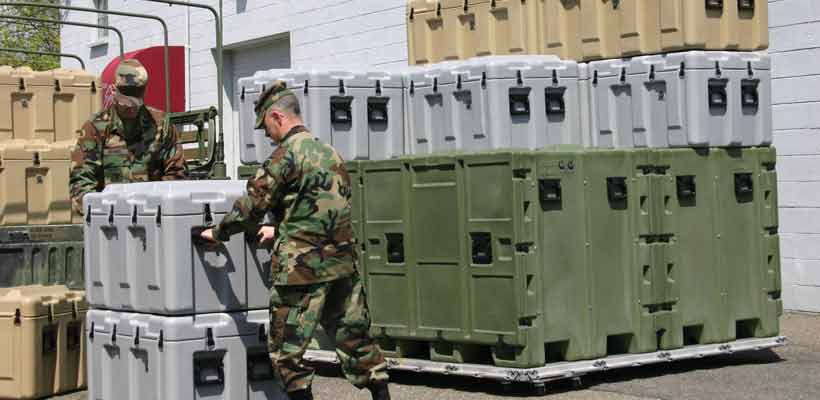
Includes clear labelling and signage
Why labelling is an essential part of the process
An essential factor in packaging for maritime transport involves accurate labelling and marking.
Clearly indicating the fragility of the contents, providing handling instructions, and highlighting any special requirements can play a surprisingly significant role in protecting your shipments.
Placing visible, durable markings, particularly widely recognised transit packaging symbols, helps transporters handle your goods correctly, thereby reducing the risk of damage.
Maritime packaging regulations
Regulations specific to maritime packaging applications
Packaging intended for shipment by sea must adhere to various regulations to ensure safety, environmental protection, and compliance with international standards.
Compliance with these regulations is essential to ensure the safe and legal transport of goods by sea, protect the environment, and prevent accidents and incidents during maritime transport. Shippers and packaging manufacturers should stay informed about relevant regulations and ensure that their packaging meets all applicable requirements before shipping by sea.
A number of the main regulations that packaging must follow for maritime transport include:
International Maritime Dangerous Goods (IMDG) code
The IMDG code regulates the transportation of dangerous goods by sea. It provides guidelines for the classification, packaging, marking, labelling, and documentation of hazardous materials to prevent accidents and protect human health and the marine environment.
International Standards for Phytosanitary Measures (ISPM)
ISPM standards, particularly ISPM 15, regulate the treatment of wood packaging materials to prevent the spread of pests and diseases through international trade. Wood packaging, such as pallets and crates, must undergo approved treatment and be marked with the appropriate certification.
National regulations
Depending on the country of origin and destination, additional national regulations may apply to packaging for maritime transport. Those regulations may cover packaging materials, labelling requirements, and customs documentation.
Maritime packaging options
What type of packaging is suitable for maritime applications?
Considering these crucial characteristics for maritime packaging, several materials and options are available. Each of these is particularly suited for specific products, industries, and applications.
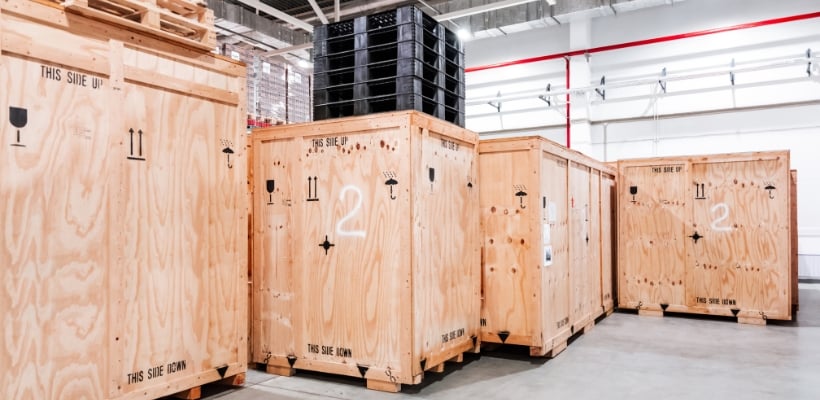
Glass-reinforced plastic (GRP) for maritime packaging
Due to several key characteristics, glass-reinforced plastic (GRP) cases are suitable for maritime packaging. They are fully waterproof, strong and durable, yet relatively lightweight, and can be reused over many trips (if a returnable supply chain is in place). Arguably, their main benefit is their availability in custom sizes. This size flexibility makes them ideal for larger industrial products, such as aircraft parts, large military equipment, industrial components, and other specialist, large, or expensive items.
Overall, the combination of corrosion resistance, waterproofing, strength, lightweight construction, customisation options, and longevity makes glass-reinforced plastic cases well-suited for maritime packaging applications.
Roto-moulded cases
Roto-moulded cases are among the toughest protective cases that are available today. They provide exceptional resistance to water (even if submerged) and the highest level of physical protection.
As a result, their use is commonplace in mission-critical applications, where tools, parts, or equipment cannot become damaged (due to the potential consequences).
Roto-moulded cases are, therefore, frequently used in naval applications, but their inherent properties also make them a good, off-the-shelf alternative to GRP containers.
Waterproof cases
Smaller waterproof cases, such as those manufactured by Peli, Explorer, Nanuk, and SKB, are ideal for protecting tools and equipment used by engineers or maintenance staff in offshore environments.
To protect contents from moisture and physical damage, waterproof cases are typically supplied with custom foam inserts. These inserts provide additional protection and aid productivity by organising tools and preventing loss.
Aluminium cases
It is a common misconception that aluminium cases rust when exposed to moisture. A thin layer of surface oxidation forms, preventing further damage to the case.
As aluminium cases are also exceptionally lightweight and often compatible with standard pallet sizes, they can be suited to specific maritime packaging applications.

Wooden shipping crates
Wooden shipping crates are another popular option for maritime packaging.
They are lightweight, cost-effective, and widely accepted by most transit providers.
However, they provide little protection from moisture and inclement conditions, so depending on their contents, you may require secondary packaging (including internal and external wraps and linings).
Summary
Adopting packaging solutions in maritime logistics
There are many considerations regarding maritime packaging, with material selection, additional protection, customisable options and regulations all being vital.
At GWP, we have over 30 years of experience in providing maritime packaging to several businesses. Alongside ensuring your packaging meets your requirements, we have a track record of delivering goods with secure packaging solutions that offer a genuine competitive advantage.
If you would like further information or advice on maritime packaging, including how yours can comply with the regulations, please do not hesitate to get in touch.
About the author

Stuart boasts over 20 years of top-level experience as a packaging design engineer, in roles at Insit Moulded Packaging (IMP) and Macfarlane.
Important note
Due to the regulated nature of the topic this guide addresses (export packaging) we have taken extra steps to ensure its accuracy and reliability. You can find out more in our content policy.
All information is, to the best of our knowledge, accurate and correct at the time of publication. Please also note that, as all scenarios vary, not all information contained in this guide may apply to your specific application. There may also be specific regulations or laws, not covered within this particular guide, that apply. Please view the list of export packaging regulations for further details.
Share this article
Further reading
Products in this guide
Get in touch
Related guides
What is seaworthy packaging? A detailed guide
7 advantages of using wooden export crates (and 5 disadvantages)
Peli vs Storm cases: A detailed review and analysis
The 6 signs you need protective foam inserts
Best equipment cases: Choosing a waterproof case
Export packaging guide – 7 considerations for international shipping
Shipping cases: 5 options for safe transit of goods

























